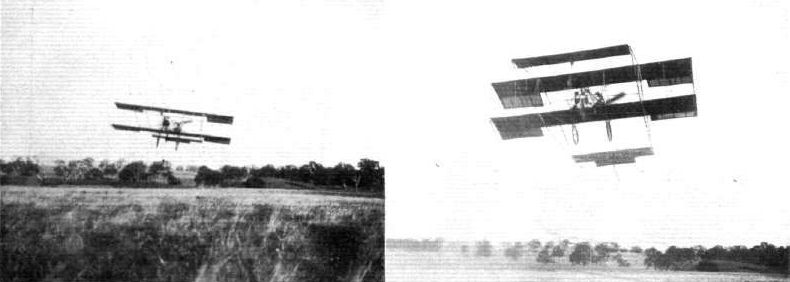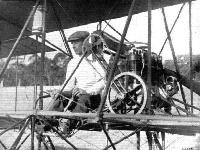
Описание
Страна: Австралия
Год: 1910
Журнал Flight
Flight, June 10, 1911.
AN AUSTRALIAN PIONEER AND CONSTRUCTOR.
WRITING from Spring Plains, Mia Mia, Victoria, Mr. J. K. Duigan sends us some very interesting particulars and photographs of his pioneer work in Australia which has ended in his construction of a successful biplane. Mr. Duigan tells his story thus:-
"I am sending a couple of photos of two recent flights I made here with a machine built entirely by myself with the exception of the engine. I have been working on it for about two years now, having to do all my own experimenting, make all fittings, wheel gears, propeller-shaft, as well as design it all. The wheel gear was originally sprung but not trailing, and this caused the only two breakages I have had. Since altering it to trailing I have had 25 flights, most over 100 yards, many over 200, and three of about a quarter of a mile, the only damage being two slightly bent plunger rods on one landing due to the piston sticking. The springs are compressed air. My engine was built here, originally being a 4-cyl. vertical air-cooled 86 by 108 mm., and weighing about 135 lbs. Since then I fitted water-cooled heads, which was an improvement, but the power was not great enough, so I fitted larger cylinders, 94 mm., with same heads, and this has given the flights shown. I have had endless difficulties, but have managed to overcome them all, and have made a machine that will lift in about 50 yards, and is under perfect control and can be trusted to always land safely. The machine is 25 ft. wide and about 28 ft. long, and weighs with 10-stone operator about 620 lbs. Engine is 138 lbs., 1 gal. water 10 lbs., radiator, centrifugal (all designed and made by myself), 7 lbs., piping 2 lbs.; total of engine and water-cooling 165 lbs. Propeller, shaft, stays to take pull of chain, and thrust-stays, about 40 lbs. This leaves 275 lbs. for the machine, minus engine and operator, which is light as it is all ash with the exception of the ribs, and is all double-surfaced with Dunlop material, made here.
"Both photos were taken when the machine was about 110 yards from starting-point. All the calculations were based on Sir H. Maxim's figures given in his excellent book on artificial and natural flight, and that book has been all I have had to work on.
"I have been a subscriber to your paper for over a year now, but have not previously sent any photos. The machine is very different now in appearance to when first completed. My first successful controlled flight was on October 7th, 1910, when I flew 196 yards at a height of about 12 feet. I had had hops long before that but the machine was not quite under control. That 196 yards flight was the first successful flight by an Australian built machine. The engine also was made in Melbourne by J. E. Tilly, a motor engineer. The ground I use for flying limits me to a bit over a quarter of a mile and there is no other in the district, so I have done about all I can do now. At present I am considering my next move, which may possibly be in your direction."
Flight, April 6, 1912.
AVIATION IN AUSTRALIA AND PIONEERS.
By J. R. DUIGAN.
I WAS very interested to see in FLIGHT of March 16th an article on "Aviation in Australia and Pioneers," and as the subject is evidently of interest I am sending you a brief account with photos of my own early efforts.
1st attempt, 1909. A pair of wings only. Result, not a success.
2nd effort, early 1910. 1/2-size Wright glider (Photo enclosed). Flown in strong winds, anchored to 120 yards of fencing wire. Left ground successfully and rose 4 or 5 ft.
3rd effort. This machine was commenced beginning of 1910, and was on Farman lines, built entirely by myself and fitted with a 4-cyl. vertical air-cooled engine, 20 h.p., built in Melbourne by J. E. Tilly. After sundry experiments on July 16th, 1910, I did, amongst others, a hop of 24 ft. Various improvements, such as chain drive in place of belt, water-cooled heads, higher compression, and finally larger cylinders gradually increased the length of flights till at the end of September, 1910, I managed flights of about 100 yards (see Melbourne Leader, October 1st). On October 7th, 1910, before half-adozen spectators, I successfully covered a distance of 196 yards, rising about 12 it. high (Melbourne Argus, October 8th, 1910). These flights, as far as I know, were the first to be made in Australia by an Australian-built machine. They were published in various papers practically all over Australia as such and were never contradicted. Public opinion may be judged from the fact that I received an offer of L100 to make a flight from the Melbourne Cricket Ground in December on the day of a big cycle meeting. This I was forced to refuse, the ground being totally unsuitable. M. Cugnet, as mentioned in your article, agreed to make the attempt, but owing to the ground and want of power, it ended disastrously.
On January 25th, 1911, I gave a short exhibition flight for the benefit of the Sporting Editor and the Photographer of the Melbourne Argtis. This flight was evidently appreciated, as they gave five columns and photos in the next Saturday's issue, January 28th, 1911. In April, at the Bendigo Easter Fair, I exhibited the machine, and on the last day showed it running in the arena, a ground 160 yards long, in a hollow, and surrounded by tents and buildings. Although there was a 12-14 m.p.h. wind side on, I just managed to get off the ground, land, and pull up without damaging anything. Shortly afterwards May 3rd, at the Bendigo Race-course where there was more room. I did several flights, straights and semicircles of about three-quarters of a mile before about 1,000 spectators. These were the first flights ever seen in Bendigo and it was also the first time I ever had more than 400 or 500 yards of descent ground. These flights paid me very well, and covered the cost of a good bit of experimenting.
Last exhibition flight was on May 31st, when before Mayor Hedges, representing the Defence Department, Mr. W. F. Marshall, Hon. Sec, Aerial League of Australia (Victorian Section), and others at Mia Mia, I did several flights of about half a mile. My brother also flew the machine about 600 yards at 10 or 12 ft., this being only the tecond time he was ever on it. Wind 12-15 miles per hour by anemometer.
All these flights, judged by present-day performances, seem of course very puny, but considering the many difficulties, that all the work was done single-handed, and that total breakages were only a buckled wheel, a wing tip leading edge, and an upright broken, the results were I think encouraging. Anyway, it was, in the words of the great poet, "A small thing but mine own."
- Журнал Flight
Фотографии
-
Журнал - Flight за 1911 г.
AN AUSTRALIAN BIPLANE. - Mr. J. R. Duigan in flight upon his Australian-built biplane at Mia Mia in Victoria. The machine is about 100 yards from starting point in left-hand photo and 110 yards in right-hand one. The small plane at rear is connected to elevator. The propeller is 8 ft. 6 ins. diameter and 10 ft. pitch, is driven by 3/4-in. Brampton chain, gear 19 teeth and 42. Ordinary Bosch cycle magneto, two brakes, 4-cyl. motor, Schebler carburettor, with inlet-pipe bored out.
-
Журнал - Flight за 1912 г.
AVIATION IN AUSTRALIA. - Mr. Duigan pancaking at Bendigo Race Course on May 3rd, 1911, after doing about three-quarters of a mile. He had to steer between two trees, hence his proximity to the one seen.
-
Журнал - Flight за 1912 г.
AVIATION IN AUSTRALIA. - On the left, Mr. J. R. Duigan flying over Bendigo Race Course on May 3rd, 1911. The machine had been in the air for about 200 yards when photograph was taken, and the crowd are facing the machine, out of the picture. On the right, Mr. Duigan is seen flying at second attempt in 12 m.p.h. wind on May 31st, when he landed safely.
-
Журнал - Flight за 1912 г.
Mr. J. R. Duigan on his machine, which he designed, built, and piloted himself.




